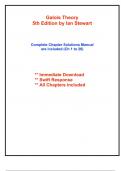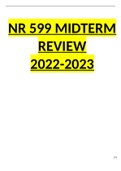Galois Theory
5th Edition by Ian Stewart
Complete Chapter Solutions Manual
are included (Ch 1 to 26)
** Immediate Download
** Swift Response
** All Chapters included
, Introduction 1
Introduction
This Solutions Manual contains solutions to all of the exercises in the Fifth Edi-
tion of Galois Theory.
Many of the exercises have several different solutions, or can be solved using
several different methods. If your solution is different from the one presented here, it
may still be correct — unless it is the kind of question that has only one answer.
The written style is informal, and the main aim is to illustrate the key ideas in-
volved in answering the questions. Instructors may need to fill in additional details
where these are straightforward, or explain assumed background material. On the
whole, I have emphasised ‘bare hands’ methods whenever possible, so some of the
exercises may have more elegant solutions that use higher-powered methods.
Ian Stewart
Coventry January 2022
1 Classical Algebra
1.1 Let u = x + iy ≡ (x, y), v = a + ib ≡ (a, b), w = p + iq ≡ (p, q). Then
uv = (x, y)(a, b)
= (xa − yb, xb + ya)
= (ax − by, bx + ay)
= (a, b)(x, y)
= vu
(uv)w = [(x, y)(a, b)](p, q)
= (xa − yb, xb + ya)(p, q)
= (xap − ybp − xbq − yaq, xaq − ybq + xbp + yap)
= (x, y)(ap − bq, aq + bp)
= (x, y)[(a, b)(p, q)]
= (uv)w
1.2 (1) Changing the signs of a, b does not affect (a/b)2 , so we may assume a, b > 0.
(2) Any non-empty set of positive integers has a minimal element. Since b > 0 is
an integer, the set of possible elements b has a minimal element.
, 2
(3) We know that a2 = 2b2 . Then
(2b − a)2 − 2(a − b)2 = 4b2 − 4ab + a2 − 2(a2 − 2ab + b2 )
= 2b2 − a2 = 0
(4) If 2b ≤ a then 4b2 ≤ a2 = 2b2 , a contradiction. If a ≤ b then 2a2 ≤ 2b2 = a2 ,
a contradiction.
(5) If a − b ≥ b then a ≥ 2b so a2 ≥ 4b2 = 2a2 , a contradiction. Now (3) contra-
dicts the minimality of b.
Note on the Greek approach.
The ancient Greeks did not use algebra. They expressed them same underlying
idea in terms of a geometric figure, Figure 1.
√
FIGURE 1: Greek proof that 2 is irrational.
Start with square ABCD and let CE = AB. Complete square AEFG. The rest of
the figure leads to a point H on AF. Clearly AC/AB = AF/AE. In modern notation,
let AB = b0 , AC = a0 . Since AB = HF = AB and BH = AC, we have AE = a0 + b0 = b,
0
say, and AF = a0 + 2b0 = a, say. Therefore a0 + b0 = b, b0 = a − b, and ab = ab0 .
√ 0 0
√ a , b are also integers,
If 2 is rational, we can make a, b integers, in which case
and the same process of constructing rationals equal to 2 with ever-decreasing
numerators and denominators could be carried out. The Greeks didn’t argue the proof
quite that way: they observed that the ‘anthyphaeresis’ of AF and AE goes on forever.
This process was their version of what we now call the continued fraction expansion
(or the Euclidean algorithm, which is equivalent). It stops after finitely many steps if
and only if the initial ratio lies in Q. See Fowler (1987) pages 33–35.
1.3 A nonzero rational can be written uniquely, up to order, as a produce of prime
powers (with a sign ±):
mk
r = ±pm 1
1 · · · pk
where the m j are integers. So
2mk
r2 = p12m1 · · · pk





